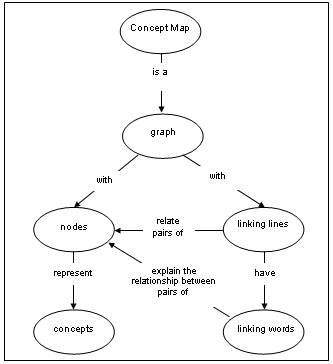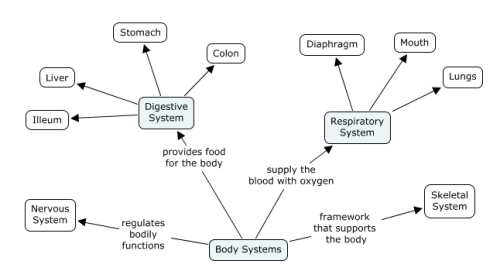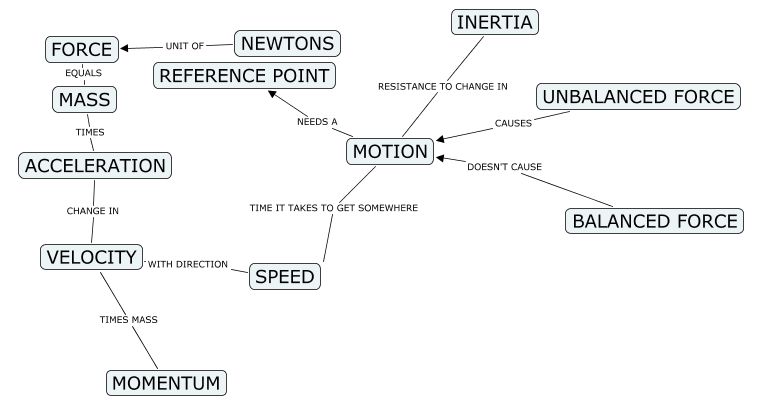From: http://redie.uabc.mx/vol2no1/contents-ruizpri.html

From: http://cayra.net/node/104

Sample Final Product (Teacher Reference)

Lesson
Plan
A
|
Click for Printer Friendly Version
| Your Name - Scott Beiter |
| Type
of Lesson - Tool |
| Lesson
Plan Title – Forces and Motion Concept Map |
| Discipline and Topic – Physical Science: Forces and Motion |
| Target
Population – Grade Level: Junior High (7-9) Population Characteristics: small city school district, inclusion Lesson Groupings: Whole class for establishing expectations and procedures. Students will be completing concept maps in cooperative groups on paper and then uniting them as a class later for work on a final product. |
| Curriculum Links – Before continuing onto Newton’s Laws of Motion students need a firm grounding in the basics of force and motion. Previous mini-units focused on relative motion, speed, acceleration, and the concept of force (a push or pull). The ideas scaffold on each other and students should understand the interdependence of these ideas. |
| Objectives
– Students will be able to: Define unit vocabulary Construct a concept map using the vocabulary Collaborate to combine terms into a concept map Critique and defend their work. |
| Media
Literacy Objectives – Prior to completion of Grade 8, students will: 4. Use content-specific tools, software, and simulations (e.g., environmental probes, graphing calculators, exploratory environments, Web tools) to support learning and research. (3, 5) 5. Apply productivity/multimedia tools and peripherals to support personal productivity, group collaboration, and learning throughout the curriculum. (3, 6) 6. Design, develop, publish, and present products (e.g., Web pages, videotapes) using technology resources that demonstrate and communicate curriculum concepts to audiences inside and outside the classroom. (4, 5, 6) 7. Collaborate with peers, experts, and others using telecommunications and collaborative tools to investigate curriculum-related problems, issues, and information, and to develop solutions or products for audiences inside and outside the classroom. (4, 5) |
| Materials and Timing – The lesson takes one 45 minute class period. Materials include: blank paper, vocabulary word list, textbook (for definitions), Interactive Whiteboard, and concept mapping program (Inspiration or cmap). |
| Scope
and Sequence – 10 minutes: Teacher begins lesson by showing students the vocabulary words on the board. The teacher leads the students into a discussion about how the words are from the whole unit of motion and forces. The students are asked if all the words are somehow connected. Students are shown an example concept map using common experiences such as sports or TV.* The teacher informs students that they will be making a concept map using the words on the board. The teacher also informs the students as to the expectations for the lesson: use all the words, all need to be connected somehow, and each connection has a linking word(s). 15 minutes: Students work in cooperative groups to put the vocabulary into a concept map. Each group should end up with one concept map that the group has come into agreement on. 15 minutes: One student comes up from each group and adds a word to the concept map on the interactive whiteboard. 5 minutes: The teacher concludes the lesson by asking if the map they constructed on the board is different than the one constructed in their group (answer should be “yes”). The teacher then asks if either their group map or the class map is incorrect. The teacher needs to lead the discussion toward making any corrections needed on the class map. Additional time can be provided the next day if necessary. *Student experience with concept maps varies. An entire lesson on concept mapping may be necessary prior to this lesson to develop proficiency in mapping skills. |
| Supplemental
Materials – Vocabulary Force Mass Acceleration Velocity Inertia Newton (N) Distance Motion Balanced Unbalanced Speed Momentum |
| Sample Concept
Maps for Instruction From: http://redie.uabc.mx/vol2no1/contents-ruizpri.html  From: http://cayra.net/node/104  Sample Final Product (Teacher Reference)  |
| Evaluation
of Students – Student work will be assessed based on the rubric
below. Outstanding = 11 to 12 pts, Fair = 9 to 10, Poor = 8 and below
|
| Evaluation
of the Lesson – The lesson will be evaluated based on the maps the students produce and their participation in class. The concept map itself is an assessment tool that allows the teacher to determine if students have met curriculum objectives. If all groups fail to produce a complete concept map the content was not taught adequately and reteaching may be required. Specific misunderstandings and gaps in knowledge can also be identified. When teaching this lesson it is important to focus on the process of revision. There is no one correct concept map. When students make spurious links there is need for editing. For this matter, no group or class should be left with incomplete or incorrect maps. Editing should continue until a quality map is achieved. Not only does this allow for better instruction, but students also leave with a sense of accomplishment. Though the teacher is leading the editing process the students should be providing input and making the decisions. When a vocabulary word is unable to be linked by the group or class there is a gap in knowledge and the teacher needs to reevaluate the teaching of that particular concept. The completed concept maps can be later printed out for classes and used as a study guide for upcoming tests and/or quizzes. A summative assessment can then be used to evaluate the understandings gained from the concept map lesson. Students should able to answer lower order thinking questions such as: Define velocity. What does an unbalanced force do? Knowing the relationship between the words should also allow students to answer higher order thinking questions such as: How are acceleration and force related? What can cause an object to accelerate? |